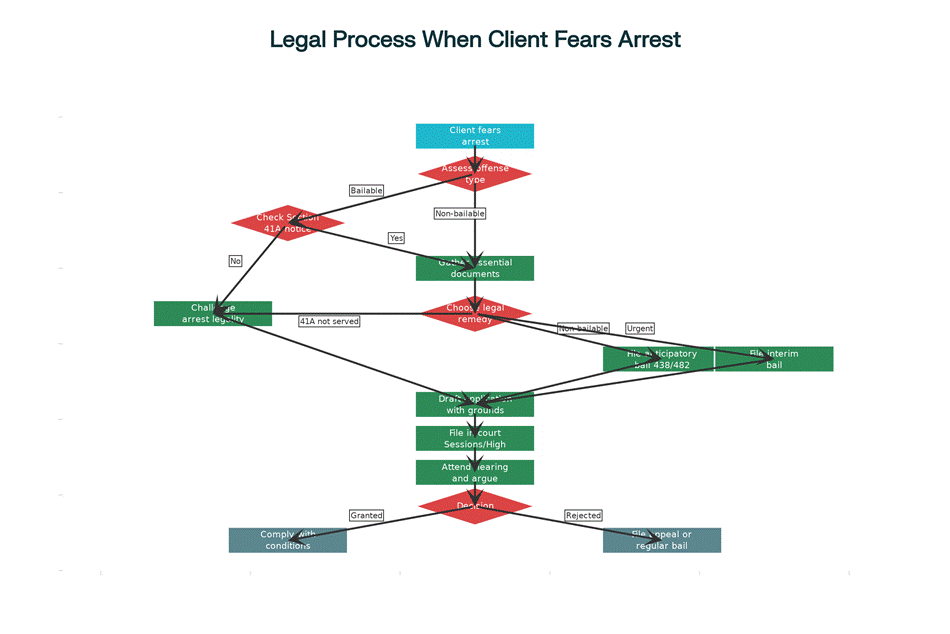Steps to Take When Your Client is Apprehending Arrest: A Comprehensive Guide for Lawyers
When a client approaches you with the fear of imminent arrest, time becomes your most critical asset. The difference between liberty and detention often lies in the swift, strategic actions taken in those crucial hours before police arrive at your client’s doorstep. Understanding the evolving legal landscape—from the traditional Code of Criminal Procedure to the new Bharatiya Nagarik Suraksha Sanhita (BNSS) 2023, Supreme Court guidelines on arrest procedures, and constitutional protections—is essential for effectively protecting your client’s fundamental rights.

Client Legal Protection Consultation Thumbnail
The apprehension of arrest triggers a complex web of legal considerations, procedural requirements, and strategic decisions that demand immediate attention. Recent developments under BNSS 2023 have expanded the scope of anticipatory bail while simultaneously introducing new procedural safeguards. The Supreme Court’s landmark rulings in cases like Arnesh Kumar v. State of Bihar have fundamentally transformed arrest procedures, making compliance with Section 41A CrPC mandatory in most cases. Understanding these developments and acting promptly can mean the difference between your client’s freedom and prolonged detention.[1][2][3][4]

Legal Action Flowchart for Client Apprehending Arrest
Immediate Assessment and Documentation Strategy
Client Consultation and Threat Evaluation
The first step involves comprehensive threat assessment and documentation. Determine whether your client faces imminent arrest (within 24-48 hours) or future apprehension based on ongoing investigation. Document the exact source of threat information: whether from investigating officers, informants, or media reports. This documentation becomes crucial evidence supporting the “reason to believe” standard required under Section 438 CrPC (now Section 482 BNSS).[5][2][6]
Assess the nature and gravity of the alleged offense. Non-bailable offenses require immediate anticipatory bail applications, while bailable offenses may allow for different strategies. Recent amendments under BNSS 2023 have removed certain restrictions that existed under state amendments to CrPC, particularly the blanket prohibition on anticipatory bail for offenses punishable with death or life imprisonment.[7][8][9][6]
Essential Documentation Collection
Immediate documentation requirements include identity proof, address verification, and income documentation. Higher income brackets require stronger evidence as courts often impose proportionate surety requirements. Collect employment certificates, ITR returns, bank statements, and property documents that may be required for bail conditions.[10][11]
Secure FIR copy or complaint details immediately. If FIR is not available, use RTI provisions to obtain investigating officer contact information and case details. Recent Supreme Court guidelines emphasize that FIR filing is not a prerequisite for anticipatory bail applications, but having case details strengthens the application significantly.[12][7][6]
Legal Analysis and Strategy Formation
Section 41A CrPC Compliance Assessment
The Arnesh Kumar guidelines have made Section 41A CrPC notice mandatory for offenses punishable up to seven years imprisonment. Verify whether investigating officers have issued Section 41A notice requiring your client to appear before them. Non-issuance of this notice provides strong grounds for challenging arrest legality and can form the basis for both anticipatory bail and constitutional remedy applications.[3][13][4][14][15]
Electronic service of Section 41A notice through WhatsApp, email, or other digital means is legally invalid. The Supreme Court has explicitly held that proper service requires physical delivery following CrPC procedures. This procedural violation can provide immediate relief through contempt proceedings against investigating officers.[4][15]
Constitutional Remedies Under Article 22
Article 22 of the Constitution provides fundamental protections against arbitrary arrest and detention. Every arrested person has the right to be informed of grounds of arrest, right to legal representation, and right to be produced before a magistrate within 24 hours. Violations of these constitutional mandates can be challenged through writ petitions under Article 226 (High Court) or Article 32 (Supreme Court).[16][17][18][19][20][21]
Recent Supreme Court judgments emphasize that personal liberty cannot be curtailed without following prescribed legal procedures. The Arnesh Kumar guidelines derive their binding force from Article 21 and Article 22, making non-compliance a constitutional violation.[18][4]
Anticipatory Bail Application Strategy
Jurisdiction and Court Selection
Choose between Sessions Court and High Court based on case complexity and urgency. Both courts have concurrent jurisdiction for anticipatory bail under Section 482 BNSS, but High Courts generally handle more complex or sensitive matters. Sessions Courts typically provide faster disposal but may have limited experience with complex legal issues.[5][22][23]
Territorial jurisdiction allows filing in the court having jurisdiction over: the place where offense occurred, where the applicant resides, or where the accused resides. This flexibility cannot be challenged by opposing parties once exercised, providing strategic advantages in forum selection.[10][5]
Application Drafting and Legal Grounds
Draft applications must include specific factual allegations supporting “reason to believe” standard. Vague or generic apprehensions will not satisfy legal requirements. Include specific information about threats received, investigating officer communications, or media reports suggesting imminent arrest.[5][12][24]
Recent Supreme Court guidelines prohibit bail applications based solely on undertakings to deposit money. All applications must be decided strictly on merits, focusing on legal grounds, cooperation assurances, and constitutional protections rather than financial inducements.[25]
Documentation and Supporting Evidence
Mandatory documents include identity proof, address verification, income evidence, and cooperation affidavit. Recent BNSS provisions allow electronic submission of affidavits in urgent cases. Ensure client personally verifies all facts as false affidavits can severely damage credibility.[10][24][6]
Include legal precedents relevant to your case circumstances. Cite recent judgments from the same High Court or Supreme Court for maximum persuasive value. Siddharam Satlingappa Mhetre v. State of Maharashtra provides comprehensive guidelines on anticipatory bail factors.[1][2][24]
Urgent Interim Applications and Emergency Procedures
Interim Anticipatory Bail Strategy
When arrest is imminent (within 24-48 hours), file urgent interim applications. Interim anticipatory bail provides temporary protection until full hearing. Courts have discretionary power to grant interim protection based on urgency and prima facie case evaluation.[26][23][27]
Urgent listing procedures require genuine emergency circumstances. Abuse of urgent listing provisions can lead to penalties and adverse court comments. Document specific threats, investigating officer statements, or other evidence supporting urgency claims.[23]
Electronic Filing and Digital Procedures
Electronic Evidence Rules 2025 facilitate digital submission in emergency situations. Video conferencing options are available for client presence requirements when physical appearance is not feasible. Digital payment of court fees is now accepted in most jurisdictions, facilitating faster processing.[23]
Ensure electronic service compliance for public prosecutor notice. Seven-day notice to public prosecutor is mandatory, and non-compliance can void anticipatory bail orders.[28]
Court Proceedings and Argumentation Strategy
Hearing Preparation and Arguments
Focus arguments on constitutional liberty protection and client cooperation. Emphasize willingness to cooperate with investigation and compliance with all court-imposed conditions. Recent Supreme Court judgments favor applicants who demonstrate genuine cooperation intent.[10][6]
Anticipate standard prosecution objections: flight risk, evidence tampering concerns, gravity of offense, and victim safety. Prepare specific responses addressing each concern with factual evidence and legal precedents.[5][10]
Condition Negotiation and Compliance
Negotiate reasonable bail conditions rather than risking rejection. Common conditions include travel restrictions, regular reporting, non-interference with witnesses, and cooperation with investigation. GPS monitoring is increasingly accepted as alternative to travel restrictions.[10][29]
Ensure client understanding of condition implications. Violation of bail conditions can lead to immediate cancellation and arrest without further hearing.[30][6]
Post-Order Compliance and Monitoring
Condition Compliance Management
Strict adherence to all court-imposed conditions is mandatory. Electronic monitoring systems now track compliance in many jurisdictions. Maintain detailed records of all condition compliance including reporting schedules, travel permissions, and investigation cooperation.[6]
Regular case monitoring is essential. Track investigation progress, charge sheet filing, and any changes in case circumstances that might affect bail status.[6]
Communication with Investigating Authorities
Maintain professional communication with investigating officers. Document all interactions to demonstrate client cooperation and good faith. Ensure client availability for questioning as and when required while protecting their legal rights.[29][31][6]
Alternative Remedies and Appellate Options
Supreme Court Appeals
If anticipatory bail is rejected by High Court, file Special Leave Petition within 90 days. Recent Supreme Court practice directions require specific grounds and compliance with filing requirements. Supreme Court generally entertains SLP only on substantial legal questions or procedural violations.[32][33]
The Supreme Court in recent 2025 judgment held that High Courts cannot restore their own dismissed anticipatory bail applications. Once rejected on merits, only appellate remedy or fresh grounds justify renewed application.[34]
Constitutional Writ Remedies
File writ petitions under Article 226 (High Court) or Article 32 (Supreme Court) for constitutional violations. Recent expansion of writ jurisdiction covers procedural violations in arrest procedures. Article 22 violations provide strong grounds for writ relief.[16][17][18][19]
Writ remedies are particularly effective when investigating officers violate Arnesh Kumar guidelines or fail to comply with Section 41A requirements.[4][15]
Regular Bail Preparation
Prepare regular bail application simultaneously as backup strategy. If anticipatory bail fails, regular bail application should be ready for immediate filing upon arrest. Recent Supreme Court guidelines allow immediate regular bail filing after anticipatory bail rejection.[16]
Recent Legal Developments and Strategic Implications
BNSS 2023 Impact on Anticipatory Bail
The Bharatiya Nagarik Suraksha Sanhita has significantly expanded anticipatory bail scope. Section 482 BNSS removes many restrictions that existed under state amendments to CrPC. The Allahabad High Court in Abdul Hameed v. State of UP ruled that BNSS applies retrospectively, benefiting clients whose offenses predate the new law.[1][2][8][9]
BNSS provisions for electronic evidence and digital procedures streamline urgent applications. Video conferencing for witness examination and client presence reduces logistical barriers.[2]
Supreme Court Guidelines on Lawyer Protection
The Supreme Court in June 2025 ruled that investigating agencies cannot directly summon lawyers for client-related matters. This protection strengthens attorney-client privilege and prevents harassment of legal representatives. Lawyers can now challenge improper summons through contempt proceedings.[35][36]
Electronic Service and Digital Evidence
Electronic service of legal notices through WhatsApp or email remains invalid despite technological advances. Proper service requires physical delivery following prescribed procedures. This principle applies to both Section 41A notices and court processes.[15]
Emergency Contact Protocols and Crisis Management
24-Hour Response Systems
Establish emergency contact protocols for crisis situations. Maintain relationships with experienced criminal lawyers for consultation during emergencies. Keep essential forms, precedents, and contact lists readily accessible.[31][37]
Document all emergency actions taken. Detailed records become crucial evidence for subsequent legal proceedings and professional compliance.[37][31]
Client Counseling and Expectation Management
Provide realistic assessment of legal options and probable outcomes. Avoid creating false hope while maintaining confidence in legal strategy. Explain all possible scenarios including arrest possibilities if legal remedies fail.[31][37][6]
Maintain regular communication with client and family members. Keep them informed of all developments and required actions.[37][31]
Practical Implementation and Best Practices
Documentation Standards
Maintain comprehensive files with chronological documentation. Digital evidence preservation is increasingly important given electronic communication prevalence. Use secure cloud storage systems for accessibility during emergencies.
Create standardized checklists for different offense categories. Anticipatory bail applications for economic offenses require different documentation than domestic violence cases.
Professional Development and Continuing Education
Stay updated on recent Supreme Court judgments and High Court precedents. Participate in criminal law workshops focusing on arrest procedures and constitutional protections. Maintain professional relationships with prosecutors and investigating officers.[31]
Understanding both CrPC and BNSS provisions is essential as transition periods create complex legal scenarios. Different courts may apply different standards depending on case filing dates and applicable law.[2][9]
Conclusion and Strategic Recommendations
Protecting clients who apprehend arrest requires mastery of multiple legal domains: criminal procedure, constitutional law, evidence requirements, and emergency legal remedies. The evolving landscape under BNSS 2023, combined with strengthened Supreme Court guidelines on arrest procedures, provides enhanced protection for individual liberty while demanding greater procedural compliance from legal practitioners.
Success in these critical situations depends on immediate assessment, comprehensive documentation, strategic court selection, and effective argumentation. The integration of traditional legal principles with modern technological tools—electronic filing, digital evidence, video conferencing—enables more efficient and effective client protection.
Most importantly, the proactive preparation of alternative remedies ensures that no client faces detention without exhausting all available legal options. Whether through anticipatory bail, constitutional writ petitions, or regular bail applications, the modern criminal defense practitioner must be prepared to deploy multiple legal strategies simultaneously.
The stakes in these cases extend beyond individual client representation to the broader protection of constitutional liberties and the rule of law. By mastering these procedures and maintaining vigilance against arbitrary state power, legal practitioners serve as the frontline guardians of individual freedom in our democratic society.
- https://thelegallock.com/analysis-of-section-4824-of-bnss-2/
- https://lawnotes.co/anticipatory-bail-under-bnss-2023-detailed-explanation/
- https://blog.ipleaders.in/arnesh-kumar-vs-state-of-bihar-2014/
- https://bhattandjoshiassociates.com/arnesh-kumar-guidelines-on-police-arrest-powers-and-contempt-gujarat-high-courts-landmark-ruling/
- https://www.legalkart.com/legal-blog/understanding-anticipatory-bail-in-india-navigating-section-438-of-the-crpc-for-pre-arrest-protection
- https://lawrato.com/legal-help-center/criminal-law/criminal-bail/guide/steps-to-get-an-anticipatory-bail-37
- https://blog.ipleaders.in/anticipatory-bail-and-judicial-interpretation-of-section-438-crpc/
- https://www.scconline.com/blog/post/2025/07/09/bnss-removed-bar-up-amendment-anticipatory-bail-s-4386-crpc-all-hc/
- https://www.freelaw.in/legalarticles/Anticipatory-Bail-Under-BNSS-What-Changed-in-2025
- https://www.advdharmendraassociates.in/post/anticipatory-bail-in-india-when-and-how-to-apply
- https://www.linkedin.com/pulse/how-draft-file-bail-application-india-under-bnss-act-2023-dutta-32xwc
- https://www.freelaw.in/legalarticles/Anticipatory-Bail-Important-Supreme-Court-Judgments-
- http://prosecutionreplenish.com/files/41-A-CrPC-New-Notes–1-.pdf
- https://www.advocatesahilkapoor.in/2025/04/automatic-arrest-and-arnesh-kumar-judgment.html
- https://cjp.org.in/upholding-procedural-compliance-supreme-court-reaffirms-electronic-service-of-notices-under-section-41a-crpc-section-35-bnss-as-invalid/
- https://restthecase.com/knowledge-bank/what-to-do-if-bail-is-rejected-in-sessions-court-in-india
- https://supremetoday.ai/search/bail-writ-alternate-remedy
- https://blog.ipleaders.in/article-22-of-the-indian-constitution/
- https://www.whiteblacklegal.co.in/details/protection-against-arbitrary-arrest-and-detention-in-india-a-legal-analysis-by—parthi-saran-r
- https://compass.rauias.com/polity/article-22/
- https://testbook.com/constitutional-articles/article-22-of-indian-constitution
- https://lawbeat.in/news-updates/do-high-courts-sessions-courts-have-concurrent-powers-to-grant-anticipatory-bail-supreme-court-says-yes-1515100
- https://thelegalschool.in/blog/difference-between-interim-bail-and-anticipatory-bail
- https://lawsikho.com/blog/use-ai-to-identify-issues-in-bail-application/
- https://www.scconline.com/blog/post/2025/08/08/supreme-court-bail-granting-procedure-no-bail-based-on-undertakings/
- https://www.scconline.com/blog/post/2021/09/13/sessions-court-rejects-anticipatory-bail-you-may-still-be-protected-for-72-hours/
- https://drnishikantjha.com/booksCollection/transit-bail-application.pdf
- https://devgan.in/crpc/section/438/
- https://www.jaagore.com/articles/know-your-police/anticipatory-bail
- https://judextutorials.com/blog/anticipatory-bail-sec-482-in-bnss
- https://www.zolvit.com/blog/legal-steps-if-arrested/
- https://www.linkedin.com/pulse/anticipatory-bail-rejected-high-court-sudhir-rao-c7j1c
- https://api.sci.gov.in/supremecourt/2019/60/60_2019_5_1501_59841_Judgement_28-Feb-2025.pdf
- https://lawbeat.in/supreme-court-news-updates/high-courts-cannot-restore-dismissed-anticipatory-bail-applications-supreme-court-1519049
- https://www.hindustantimes.com/india-news/cant-summon-lawyers-for-legal-advice-sc-101750875667718.html
- https://www.newindianexpress.com/nation/2025/Jun/25/summoning-lawyers-over-client-matters-threatens-administration-of-justice-says-sc
- https://www.snaderlawgroup.com/preparing-your-client-after-getting-arrested/
- https://theadvocatesleague.in/assets/pdf/papers/CASE_COMMENT_SUSHILA_AGGARWAL_V__NCT_DELHI.pdf
- https://lawbeat.in/supreme-court-judgments/scst-act-anticipatory-bail-supreme-courts-big-ruling-explained-1516747
- https://www.indiacode.nic.in/show-data?actid=AC_CEN_5_23_000010_197402_1517807320555&orderno=486
- https://www.sci.gov.in/sci-get-pdf/?diary_no=92372025&type=o&order_date=2025-04-09&from=latest_judgements_order
- https://cdnbbsr.s3waas.gov.in/s3ec05abdeb6f575ac5c6676b747bca8d0/uploads/2024/01/2024010521.pdf
- https://api.sci.gov.in/supremecourt/2025/26630/26630_2025_5_14_62432_Order_17-Jul-2025.pdf
- https://www.scobserver.in/journal/justice-ct-ravikumars-notable-judgements/
- https://www.ncib.in/anticipatory_bail.php
- https://www.scribd.com/document/844481703/Guide-to-Draft-Anticipatory-Bail-Application
- https://blog.ipleaders.in/how-to-protect-your-client-from-arrest/
- https://www.scribd.com/document/751416475/Anticipatry-Bail-Application-Draft-Under-SECTION-438-of-Cr-p-c-in-Sessions-or-High-Court
- https://www.scconline.com/blog/post/2025/01/07/top-criminal-law-cases-2024-important-decisions-high-courts-across-india/
- https://www.kaleeyantey.com/guide-to-anticipatory-bail-know-your-rights-before-arrest/
- https://cdnbbsr.s3waas.gov.in/s3ec053e77a14629775492504515dc4b23/uploads/2025/01/2025010493.pdf
- https://splawchambersbangalore.com/anticipatory-bail-procedure-bangalore/
- https://delhicourts.nic.in/viewdocuments/QTdPc0VsdjNtNDhWaUV3Z0x3VGVwYTU4NXVNL0hGUUVDYkVydEJFcEZJTWtCNzY4N3Y5RVE0c3VJNkVEZGZiMGFRSEZyZDZsV25JN2d3TGdpU3EyZEcwS0l2THppSlhhOEN0S1h5QnRyUms9
- https://www.pslchambers.com/article/struggles-of-getting-an-anticipatory-bail-application-listed-before-the-district-court-in-delhi-during-lockdown/
- https://lawbhoomi.com/safeguard-against-arbitrary-arrest-and-detention-article-22/
- https://delhipolice.gov.in/doc/standing-order/330.pdf
- https://www.constitutionofindia.net/articles/article-22-protection-against-arrest-and-detention-in-certain-cases/
- https://police.py.gov.in/DGP circular dt 12.03.19- Procedure for sending notice and acknowledgment us 41-A CrPC.pdf
- https://api.sci.gov.in/supremecourt/2025/2791/2791_2025_16_43_58632_Judgement_22-Jan-2025.pdf
- https://ppl-ai-code-interpreter-files.s3.amazonaws.com/web/direct-files/20da1ae231e7f37736596ba1639a375c/ff3c30ba-8501-4c83-ace6-9c0bcee98a90/11ba7546.csv
- https://ppl-ai-code-interpreter-files.s3.amazonaws.com/web/direct-files/20da1ae231e7f37736596ba1639a375c/ff3c30ba-8501-4c83-ace6-9c0bcee98a90/683d10fd.csv

















